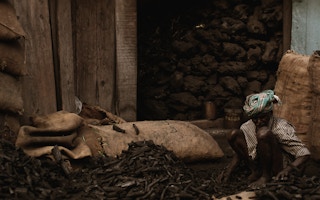The richest coal fields in India are also the most precarious for workers and those who live on them.
The threat of homes collapsing or burning down due to ground subsidence and coal fires — some of which have burned for a century — is a clear and present danger to thousands of people in Jharkand and Raniganj regions, around 300 kilometres northwest of Kolkata.
The risks of sudden death and injury frequently force people, in particular vulnerable migrant workers, into having to suddenly abandon everything and flee.
This sudden exodus results in the loss of jobs and sources of income. It also leads to social disintegration and exposes the migrants to further poverty as they struggle to find work and settle in new places.
In the Jharia coalfields, where underground fires have been burning for over 100 years, sudden land subsidence results in houses catching fire, people being killed and families being forced to abandon their properties and flee.
These are common occurrences in Jharia, but its mines also produce the finest quality coal in India, which in 2020 accounted for 44 per cent of India’s primary energy demand.
Despite the ever-present danger, many of those working the mines find it difficult to migrate and settle elsewhere, because local people fear losing their daily source of income from coal picking.
In the absence of alternate means of income, gathering burnt high-grade coal to sell in the market helps them make a living.
Even if they want to move to escape the hazards of living next to a coal mine, without any resettlement and rehabilitation schemes, most do not find an appropriate place to resettle.
The Jharia Rehabilitation and Development Authority has been created to provide people with alternative job options and help their resettlement in safer environments.
However, relocation to stable land away from coal mines often becomes a hurdle to earning a livelihood in the absence of higher wages and dearth of work opportunities in manufacturing industries, and other sectors without formal education, and results in people choosing to return to live in their dilapidated homes and engage in informal mining despite the constant dangers.
The proportion of homeless people engaged in illegal coal extraction is also quite high.
This makes planning for people to live sustainably elsewhere ineffective, as many choose not to settle there.
India’s Central Mine Planning and Design Institute has identified more than eight mine areas in the Raniganj Coalfield as high-risk and unstable, with more than 100,000 people in danger of being forced to flee due to buildings collapsing, ground subsidence, mine fires or other accidents.
The Ratibati colliery of Raniganj Community Development Block is highly susceptible to land subsidence because of the vacant labyrinth beneath the crust, and a population of above 30,000 threatened with either an imminent cave-in or becoming a victim of shock mobility.
Houses have suddenly collapsed in the towns of Parashkol, Jambad, Majhipara and others near coal mines in Ondal Block as the ground beneath them gave way.
In 2020, an exodus of people followed because of ground subsidence in the Madhabpur open-cast mine of Raniganj Coalfield.
More than 400 people fled to find shelter elsewhere, as their houses developed cracks or collapsed.
Normally, those fleeing due to such shocks are offered compensation at a safer site for the land and houses they have lost, and one member of the displaced family is offered a government job.
However, the rehabilitation agencies allege that many residents encroach on land owned by Coal India Limited and then claim rehabilitation benefits.
The local inhabitants blame the lack of coordination between the Asansol Durgapur Development Authority and officials of the mining company, Eastern Coalfields Limited, and the housing department of West Bengal, for the lack of implementation of rehabilitation packages.
In cases of land subsidence and mine fire outbreaks, residents living in land adjoining the collieries are sometimes swiftly shifted to abandoned Eastern Coalfields Limited quarters that only have piped water connections.
At times potable water is unavailable due to pipes being broken by land subsidence and people have to struggle with daily life amidst these uncertainties.
The monsoon also brings more risks for inhabitants with excessive rainfall causing flooding.
The September 2021 deluge in the Raniganj coalfield flooded the open-cast mines and stranded people without water, food and medical supplies in submerged areas near the collieries for almost a week, with coal seams remaining inaccessible to workers for about three months.
They had to be rescued and shifted away from their waterlogged homes by the disaster response forces of the Disaster Management and Civil Defence Department of West Bengal.
In many ways the sudden, mass movement of people in coal mining regions is inevitable.
Coal mining draws poor and marginalised people to eke out a living from the burning seams, foraging through scraps of half-burnt coal, despite the risks to their lives.
The expansion, operations and production of coal in India makes land unstable, prone to subsidence and fire.
In this era of global pledges for the reduction of carbon footprints and greenhouse gas emissions, this brings into question whether expanding coal mining operations should continue.
Perhaps now is the time when planning for the transition to sustainable energy should also include devising alternative livelihoods for residents dependent on coal scavenging and informal coal mining.
Dr Shatabdi Das is a researcher with the Calcutta Research Group. Her research interests include human migration, displacement, borderlands, issues of urban development and climate, and environmental and ecological studies.
This article is part of a Special Report on ‘Shock mobility’, produced in collaboration with the Calcutta Research Group. If this article has raised issues for you, or if you’re concerned about someone you know, visit https://findahelpline.com/i/iasp.
Originally published under Creative Commons by 360info™.










